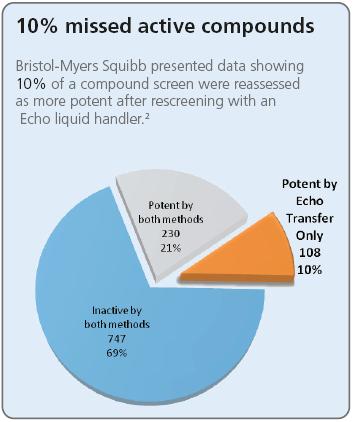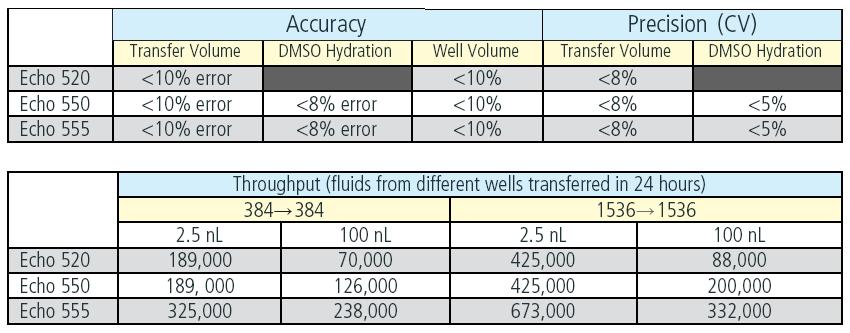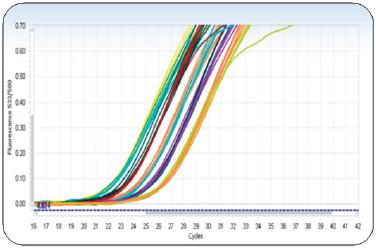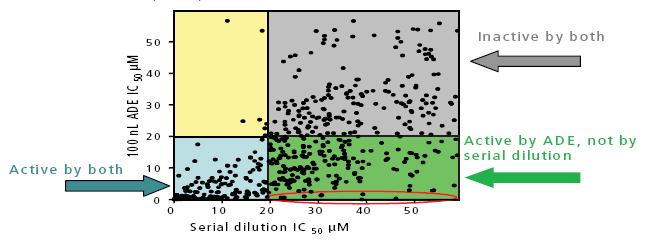Features and advantages of Echo non-contact nano-optimized sonic pipetting system
Shanghai Dian Biotech (Shanghai) Ltd.
The American Labcyte Echo 500 Series Non-Contact Nano-Upgrade Acoustic Pipetting System is the industry's most trusted micro-liquid pipetting system. Unlike other pipettes, they use a liquid-liquid (Move Liquids with Sound) instead of a tip or nozzle. The Echo 500 Series revolutionizes the pipetting system, which emits sound waves from beneath the hole in the source plate of the motherboard and "listens" to its echo to determine the composition of the liquid in the well and the height of the liquid, including the water content in the DMSO. These are automated and take only a few microseconds to allow 2.5 nl of liquid to be accurately transferred to the corresponding hole in the target plate of the inverted target plate above it. This is the Acoustic Droplet Ejection (ADE: Acoustic Droplet Ejection) - a small amount of liquid is excited by sound waves to another microplate for pipetting. The large volume of liquid transfer is achieved by transferring hundreds of drops of liquid per second, and the Echo 555 can transfer up to 500 drops per second. The pipetting range is 2.5 to 10000 nl, and the extended transfer time can transfer a larger volume of liquid. Pipetting volume accuracy: less than 10% target volume deviation; precision: less than 8% CV.
The sonic pipetting process is shown in Figure 1. It is possible to perform a cherry-pick transfer from any well to any well and operate independently for each sample. Thanks to the use of sonic energy pipetting, non-contact pipetting can be achieved without the advantages of using a tip or nozzle, without cross-contamination and blockage of liquids, and without the need for tips such as tips on other traditional pipetting equipment. Or you need to clean the tip.

Figure 1: Echo uses a schematic diagram of sonic pipetting. The liquid adheres to the target plate hole due to surface tension. The motherboard is an Echo Qualified 384 or 1536 well plate. The target plate is a 96, 384, 1536 or 3456 well plate of the SBS standard.
Advantages of the Echo 500 series pipetting system: 1) It can be pre-calibrated according to the type of liquid required by the customer, and can be used at the delivery machine to avoid the inconvenience and possible inaccuracy of the customer to adjust the instrument. 2) Non-contact pipetting operation, no gun head, no nozzle, no need to use pin tool, meaning no cross contamination and consumption of gun head, washing liquid, intermediate plate and so on. 3) The moisture content of DMSO and the filling volume of the liquid in the well can be automatically detected. 4) The pipetting volume can be as low as 2.5 nL. 5) Pipetting volume accuracy: less than 10% target volume deviation; precision: less than 8% CV. 6) Accuracy of measuring DMSO moisture content: less than 8%; precision: less than 5% CV. 7) Transfer simple liquids (cell culture media, buffer or DMSO) or transfer high viscosity liquids (lysates, antibodies with glycerol or transfection reagents). cDNA, proteins, living cells, protein crystals and other components can be transferred without damage. 7) Echo 520 and 550 can be upgraded according to customer needs. 8) Automation and integration can be easily achieved, such as integration with Access Laboratory Workstation and POD Automation Platform, which can work 24 hours a day.
Traditional pipetting equipment requires two steps: aspiration and drainage, and accuracy and precision are guaranteed within the optimal volume range. Echo repeatedly transfers 2.5nl of solution, so accuracy and precision are consistent over a wide range of volumes. As shown in Figure 2, the precision of traditional pipetting equipment is reduced when transferring smaller volumes of liquid (CV is increased), different liquids are required to transfer different ranges of liquids, and Echo's precision is in a wide range of pipetting volumes. It is 2.5% in range and is especially suitable for pipetting volumes as low as nano upgrades.
Figure 2: Traditional pipetting equipment reduces precision when transferring smaller volumes of liquid (increased CV), transferring different ranges of liquid requires different pipetting equipment, and Echo's precision is within a wide range of pipetting volumes It is 2.5%, especially suitable for pipetting volumes down to nano-upgrade.
The results can be optimized by transferring the liquid with Echo. The operation of conventional pipetting equipment is based on the basic assumption that the inner and outer walls of the tip do not stick to small molecules or proteins in the liquid. In fact, this assumption is not true in many cases, especially when transferring high viscosity and micro volume liquids.
Figure 3: Comparison of IC50 obtained by conventional gradient dilution pipetting and sonic pipetting (ADE)
As shown in Figure 3, IC50 values ​​for concentration gradients were obtained using different methods for more than 1000 samples. The X-axis represents the IC50 value of the sample obtained by pipetting with conventional gradient dilution, and the Y-axis represents the IC50 value obtained by the sonic pipetting method (ADE). A sample with an IC50 value of less than 20 μM is a satisfactory sample. Therefore, the blue region is the active sample region where both methods are positive; the gray region is the inactive sample region where both methods are negative; the green region is positive by sonic pipetting, and is negative by conventional gradient dilution method. The sample area; the yellow area is the area that is positive by conventional gradient dilution and negative by sonic pipetting. As can be seen from the figure, the green area concentrates about 10% of the sample points, and even the points in the red circle have a very low IC50 value obtained by pipetting the liquid, which is close to 0, and these points are discarded in the conventional pipetting method. of. The dots in the yellow region are few and are concentrated near the critical line of IC50 = 20 μM. The traditional gradient dilution pipetting method produces such a large false negative result because the sample sticks to the tip during the pipetting process, so the amount of liquid actually transferred is not accurate. And the error accumulates during gradient dilution - some samples show up to three times the loss of biological activity when using gradient dilution.
Figure 4 and Figure 5 are the screening results of the potential active compounds obtained by Bristol-Myers Squibb and AstraZeneca, respectively, and the comparison table of IC50, which further demonstrates that better results can be obtained by the method of sonic pipetting.


Figure 4: Comparison of screening results for potentially active compounds obtained by Bristol-Myers Squibb
Figure 5: Comparison table of IC50 obtained by AstraZeneca in two ways
The flow of Echo pipetting is quite different from the process of traditional gradient dilution pipetting. The process of traditional gradient dilution pipetting is shown in Figure 6. The sample must be transferred to an intermediate plate and then diluted by gradient. Transfer to generate the assay plate. Gradient dilution requires additional cleaning of the tip to prevent cross-contamination or the use of a disposable tip but increases the cost of the experiment. A large number of processes using the tip transfer can greatly accumulate errors, resulting in inaccurate pipetting results.
Figure 6: Flow of traditional gradient dilution pipetting
The Echo pipetting process is shown in Figure 7. In the two-step process, an intermediate plate is required to generate four intermediate concentrations, which are then diluted to produce an assay plate. In the direct dilution method, the inert plate can be directly diluted without the intermediate plate. These processes can be done with Echo's Cherry Pick and Dose-Response applications without the need to produce tips, lotions and other experimental consumption. When the experimental process is streamlined, productivity is increased, cost savings and error reduction. The accuracy and sophistication of Echo pipetting also allows the operator to reduce the number of repetitions of the experiment, and it can significantly reduce the volume of samples required for the experiment, saving valuable samples and reagents. These can increase the cost advantage of using Echo.
Figure 7: Echo pipetting process: two-step dilution and direct dilution
According to the actual flux demand, the Echo 500 series is available in 520, 550 and 555 models. All three models offer the same accuracy and precision. The Echo555 pipetting system is the world's fastest sonic pipetting platform. Within 24 hours, when the pipetting amount is 2.5 nL, a maximum of 640,000 samples are transferred; when the pipetting amount is 50 nL, a maximum of 463,000 samples are transferred. The Echo 555 pipetting system measures and reports the volume of liquid in each well and the water content of DMSO, making it ideal for high throughput liquid handling laboratories. The Echo 550 is the world's first sonic pipetting system for life science applications, and the award-winning Echo 550 pipetting system remains the world's leading pharmaceutical company for ultra-low volume pipetting. Like the Echo 555 pipetting system, it also detects and reports the volume of liquid and the water content of DMSO. The Echo 520 pipetting system provides a more economical solution for laboratories with lower throughput. The Echo 520 pipetting system measures the volume in the microplate and the DMSO moisture content, but only shows the volume without reporting DMSO moisture. The lower end of these Echo 500 series can be upgraded to higher end products to meet customer needs. Figure 8 is a comparison of the pipetting accuracy, precision, and throughput of the Echo 500 Series pipetting system.

Figure 8: Pipetting accuracy, precision and throughput of the Echo 500 Series pipetting system.
Echo's software helps customers build pipetting solutions for a variety of applications. Each Echo application is built around a specific pipetting process and uses a wizard and graphical interface to streamline the process. In practice, customers can quickly create a series of pipetting solutions offline, then use the built-in simulator to verify each step of pipetting, and finally run the instrument. Echo software includes: Echo Plate Reformat (reset and copy samples into the board; quickly design complex plate maps), Echo Cherry Pick (transfer and copy samples according to the pick list; graphical design of traditional or custom target board layouts) and Echo Dose-Response (Generates the IC50 curve and automatically fills the fill; automatically generates the intermediate plate required for the direct dilution method; designs the layout of the plate including the control well).
Echo can be used in Assay Miniaturization, Assay Optimization, Dose Response, Genothingping, DNA Sequencing, RNAi Assay, Protein Crystallography and other fields. For example, to minimize qPCR experiments, the total experimental volume can be as low as 250 nl, with each individual component transferred with Echo as low as 50 nl. As shown in Figure 9, green indicates that cDNA is contained, and red indicates no cDNA. The experimental results show no cross-contamination, and the amplification results are comparable to those obtained in the conventional volume.


Figure 9: qPCR experiments with Echo, green for cDNA and red for cDNA.
Currently, the top ten global pharmaceutical companies have adopted Echo sonic pipetting equipment, including small and medium-sized pharmaceutical companies, biotechnology companies, contract research organizations and academic institutions. Labcyte's clients span a wide range of biology, including drug discovery, genomics, proteomics, diagnostics, imaging mass spectrometry, and transport of living cells. Echo has obtained 41 patents in the US, 8 in Europe, 3 in Japan, 1 in China, and some US and international patents are pending.
For more information, please refer to the Labcyte website: and Shanghai Dian Biotech Co., Ltd. Website:
Shanghai Dian Biotech Co., Ltd. Contact: Room 2101, Building 6, Huiyang Building, 1139 Pudong Avenue, Shanghai. Tel: (+86) 21-58605185, fax: (+86) 21-51973282, E-mail:
Clarified Goji Juice

"All medicines have their own environment", Zhongning's unique natural conditions have created "the unique quality of Zhongning goji"
First. Soil: Zhongning is located in the central part of Ningxia Hui Autonomous Region, surrounded by mountains. The Yellow River and Qingshui River flow through the county. Large areas of alluvial plains are formed on both sides of the Yellow River. The land is deep and fertile, rich in more than 30 kinds of trace elements required by goji. The main root of goji is more than 3 meters deep, and the lateral roots are criss-crossed, with strong sprouting power and soil penetration. Therefore, Zhongning's unique and fertile soil provides sufficient organic nutrients for the growth and development of goji.
Second, water quality: Qingshui River, the largest tributary of the Yellow River that flows through Zhongning County, flows into the Yellow River in Zhongning County. It is a typical arid and semi-arid river with extremely high salinity, and more bitter goes more downstream. It is precisely because of the unique water quality of Qingshui River that creates the unique quality of the soil here.
Third, climate: Zhongning County is located in the transition zone between the Inner Mongolia Plateau and the Loess Plateau, and belongs to the northern temperate continental monsoon climate zone. Surrounded by mountains, with sufficient sunlight, drought and little rain, strong evaporation, effective accumulated temperature of 3363℃, high accumulated temperature, good heat conditions, which is conducive to the growth of goji, the annual sunshine time is as long as 2970h, which is significantly higher than the 2600 hours required for the growth of high-quality goji.
These unique natural conditions make Zhongning goji enjoy the reputation of "the best in the world".
From hand-picking, thorough washing, cold pressing and bottling. Our NFC Goji Juice never exceeds 6 hours to complete the gorgeous turn of fresh goji berries from the field to the sweet nectar ready for the tip of your tongue. Our diligence ensures all the active nutrients such as Lycium barbarum polysaccharide, Betaine, Carotenoids can be fully retained without any water, pigment or preservative added.
Ways of drinking Goji Berry Juice:
Drink directly,
Tea,
Baking ingredients,
Beverage ingredients
Goji Berry Serum Benefits
â—Reduce cholesterol.
â—Anti-cancer.
â—Support normal kidney function.
â—Will-being.
â—Support healthy liver function.
â—Support eye health and improves vision.
â—Balance blood pressure and serum sugar.
â—Treat sexual dysfunction.
Clarified Goji Juice,Goji Berry For Raw Material,Anti Aging Clear Juice,Fresh Squeezed Clarified Goji Juice
Ningxia Red Power Goji Co., Ltd. , https://www.redpowergoji.com










